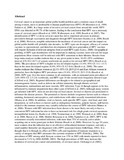| dc.identifier.citation | Lucy Muchiri, Christine B. Sekkade-Kigondu, Gathari Ndirangu, Peter Gichangi, James Machoki, Benson B.A. Estambale, Marleen Temmerman,he Impact of Human Immunodeficiency Virus and Human Papillomavirus Co-Infection on HPV Genotype Distribution and Cervical Lesion Grade in a Semi-Urban Population in Tigoni, Kenya(2013) | en |
| dc.description.abstract | Cervical cancer is an important global public health
problem and a common cause of death among women,
and it is attributable to human papillomavirus (HPV)
(Walboomers et al, 1999; Parkin et al, 2008). In a large
series of invasive cervical cancer from around the
world, HPV-DNA was detected in 99.7% of the tumors,
leading to the conclusion that HPV was a necessary
cause of cervical cancer (Bosch et al, 1995; Walboomers
et al, 1999; Bosch et al, 2007). The identification of
HPV’s role in cervical cancer has led to important
advances in primary prevention through vaccination
and diagnosis through HPV detection (Stanley et al,
2008; Bosch et al, 2008). However, tangible reduction
in the incidence of cervical cancer and the impact on
global public health will probably take decades. As HPV
types are divergent, efficacy of current vaccines is typerestricted,
and therefore development of the next
generation of HPV vaccines will require inclusion of
relevant antigens from several HPV types (Lowy, 2008).
Geographical profiling of HPV type distribution will be
important in making vaccines more relevant for target
populations.Most women will be infected with HPV sometime in
their lifetime. Results from large meta-analyses studies
indicate that at any given point in time, 10.4% (95%
confidence interval (CI) 10.2-10.7) of women
worldwide are positive for cervical HPV DNA (Bosch et
al, 2008). The prevalence of HPV is higher in less
developed regions (13.4%; 95% CI: 13.1-13.7) than in
the more developed regions (8.4%; 95% CI: 8.3-8.6)
(Bosch et al, 2008). The same studies indicate that
African women at 22.1% (95% CI: 20.9-23.4) and East
African women in particular, have the highest HPV
prevalence rates (31.6%; 95% CI: 29.5-33.8) (Bosch et
al, 2008). HPV type 16 is the most common in all
continents, with an estimated point prevalence of 2.6%
(95% CI: 2.5-2.8) worldwide, and HPV type 18 the
second most frequently detected type (Clifford et al,
2005). Regional differences are thought to be related to
geographical and immunogenetic factors, such as
defects in cellular immunity through chronic cervical
inflammation, malnutrition and more recently, HIV
infection; Type 16 though appears to be less influenced
by immune impairment than other types (Clifford et al,
2005).Although many women get infected with HPV, most do
not develop cervical cancer. Several co-factors are
postulated to influence the disease process. The
potential co-factors include exogenous factors such as
tobacco smoking, hormonal contraceptives, and coinfections
with other sexually transmitted infections
(Munoz et al, 2006). In addition, viral co-factors, such
specific HPV types, viral load, and viral integration, as
well as host co-factors such as endogenous hormones,
genetic factors, and factors related to the immune
response may variably influence the course of HPV
infection (Munoz et al, 2006).
Women with HIV infection have been shown to be more
likely not only to have a concurrent HPV infection but
also to have an increased risk for a high grade cervical
squamous intraepithelial lesion (La Ruche et al, 1998;
Temmerman et al, 1999; Womack et al, 2000; Baay et al,
2004; Hawes et al, 2006; Didelot-Rousseau et al, 2006;
Ngándwe et al, 2007). HPV is the commonest sexually
transmitted infection, with more than 75% of sexually
active adults acquiring one or more genotypes in their
lifetime (Bosch et al, 2008). However, by age 30 years,
most women clear the infection due to an effective cellmediated
immune response, and only a small number
thereafter are diagnosed with a HPV-associated lesion
(Schiffman, 1992). It is thought that it is through its
effect on CD4+ cells and regulation of immune
responses to a variety of antigens that HIV attenuates
the systemic response to HPV (Palefsky, 2006).
The prevalence of HIV among adult Kenyan women was
13% in 2003 with trends reported to have decreased to
5.1% by 2006 (KDHS, 2003). The high prevalence of
HIV may increase the incidence of cervical pre-cancer
and potentially, of cervical cancer. Gichangi et al (2002),
however, demonstrated that a two to three-fold
increase in HIV prevalence did not translate to a
proportionate increment in incidence of cervical cancer.
They hypothesized that HIV-infected women die from
HIV-related opportunistic infections before they
develop invasive cervical cancer. The mean survival
time for women with HIV in 2008 was reported to be 5
years (Yamada et al, 2008) while typically more than 10
years elapse before the development of cervical cancer
after HPV infection. Yamada et al (2008) also advanced
the possibility that sub-clinical cervical cancer may be
missed in many women dying prematurely from AIDSrelated
opportunistic infections.
This study was carried out to establish whether the coinfection
of HIV and HPV has an influence on HPV
genotype distribution and on the prevalence and grade
of cervical neoplasia. | en |

